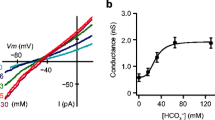Summary
The relations between K+ channel and Cl− channel currents and mycoplasma infection status were studied longitudinally in HSG cells, a human submandibular gland cell line. The K+ channel currents were disrupted by the occurrence of mycoplasma infection: muscarinic activation of K+ channels and K+ channel expression as estimated by ionomycin- or hypotonically induced K+ current responses were all decreased. Similar decreases in ionomycin- and hypotonically induced responses were observed for Cl− channels, but only the latter decrease was statistically significant. Also, Cl− currents could be elicited more frequently than K+ currents (63% of cases versus 0%) in infected cells when tested by exposure to hypotonic media, indicating that mycoplasma infection affects K+ channels relatively more than Cl− channels. These changes occurred in the originally infected cells, were ameliorated when the infection was cleared with sparfloxacin, and recurred when the cells were reinfected. Such changes would be expected to result in hyposecretion of salivary fluid if they occurredin vivo.
Similar content being viewed by others
References
Ahmed, M. A. Curing mycoplasma in tissue culture with two newer quinolones: sparfloxacin and OPC17116 [MSc. thesis]. Seattle: University of Washington; 1993.
Balter, M. Montagnier pursues the mycoplasma-AIDS link. Science (Washington, DC) 251:271; 1991.
Bauer, F. A.; Wear, D. J.; Angritt, P., et al.Mycoplasma fermentans (incognitus strain) infection in the kidneys of patients with acquired immunodeficiency syndrome and associated nephropathy: a light microscopic, immunohistochemical and ultrastructural study. Human Pathol. 22:932–933; 1991.
Blanchard, A.; Montagnier, L. AIDS-associated mycoplasmas. Annu. Rev. Microbiol. 48:687–712; 1994.
Boatman, E.; Cartwright, F.; Kenny, G. Morphology, morphometry and electron microscopy of HeLa cells infected with bovineMycoplasma. Cell Tissue Res. 170:1–16; 1976.
Caplan, S.; Gallily, R.; Barenholz, Y. Characterization and purification of a mycoplasma membrane-derived macrophage-activating factor. Cancer Immunol. Immunotherapy 39:27–33; 1994.
Chowdhury, I. H.; Munakata, T.; Koyanagi, Y., et al. Mycoplasma can enhance HIV replication in vitro: a possible cofactor responsible for the progression of AIDS. Biochem. Biophys. Res. Commun. 170: 1365–1367; 1990.
Clyde, W. A. Mycoplasma species identification based upon growth inhibition by specific antisera. J. Immunol. 92:955–965; 1964.
DeBey, M. C.; Jacobson, C. D.; Ross, R. F. Histochemical and morphologic changes of porcine airway epithelial cells in response to infection withMycoplasma hyopneumoniae. Am. J. Vet. Res. 53:1705–1710; 1992.
DeBey, M. C.; Ross, R. F. Ciliostasis and loss of cilia induced byMycoplasma hyopneumoniae in porcine tracheal organ cultures. Infect. Immun. 62:5312–5318; 1994.
Dimitrov, D. S.; Franzoso, G.; Salman, M., et al.Mycoplasma fermentans (incognitus strain) cells are able to fuse with T lymphocytes. Clin. Infect. Dis. 17:S305-S308; 1993.
Fatherazi, S.; Izutsu, K. T.; Wellner, R. B., et al. Hypotonically activated chloride current in HSG cells. J. Membr. Biol. 142:181–193; 1994.
Herbelin, A.; Ruuth, E.; Delorme, D., et al.Mycoplasma arginini TUH-14 membrane lipoproteins induce production of interleukin-1, interleukin-6, and tumor necrosis factor alphas by human monocytes. Infect. Immun. 62:4690–4694; 1994.
Izutsu, K. T.; Fatherazi, S.; Wellner, R. B., et al. Characteristics and regulation of a muscarinically activated K current in HSG-PA cells. Am. J. Physiol. 266:C58-C66; 1994.
Kenny, G. E. Manual of clinical microbiology. In: Balows, A.; Hausler, W. J., et al., ed. Washington, DC: American Society for Microbiology; 1991:478–482.
Kenny, G. E.; Cartwright, F. D. Susceptibility ofMycoplasma pneumoniae to several new quinolones, tetracycline, and erythromycin. Antimicrob. Agents Chemother. 35:587–589; 1991.
Kenny, G. E.; Cartwright, F. D. Susceptibilities ofMycoplasma hominis andUreaplasma urealyticum to two new quinolones, sparfloxacin and WIN 57273. Antimicrob. Agents Chemother. 35:1515–1516; 1991.
Lau, K. R.; Howorth, A. J.; Case, R. M. The effects of bumetanide, amiloride and Ba2+ on fluid and electrolyte secretion in rabbit salivary gland. J. Physiol. (Lond.) 425:407–427; 1990.
Lemaitre, M.; Henin, Y.; Destouesse, F., et al. Role of mycoplasma infection in the cytopathic effect induced by human immunodeficiency virus type 1 in infected cell lines. Infect. Immun. 60:742–748; 1992.
Lo, S. C.; Hayes, M. M.; Kotani, H., et al. Adhesion onto and invasion into mammalian cells byMycoplasma penetrans: a newly isolated mycoplasma from patients with AIDS. Mod. Pathol. 6:276–280; 1993.
Montagnier, L.; Blanchard, A. Mycoplasmas as cofactors in infection due to the human immunodeficiency virus. Clin. Infect. Dis. 17, Suppl. 1: S309-S315; 1993.
Nir-Paz, R.; Israel, S.; Honigman, A., et al. Mycoplasmas regulate HIV-LTR-dependent gene expression. FEMS Microbiol. Lett., 128:63–68; 1995.
Patton, L. L.; Wellner, R. B. Established salivary cell lines. In: Dobrosielski-Vergona, K., ed. Biology of the salivary glands. Boca Raton: CRC Press; 1993:319–341.
Pollack, J. D.; Jones, M. A.; Williams, M. V. The metabolism of AIDS-associated mycoplasmas. Clin. Infect. Dis. 17:S267–271; 1993.
Russell, W. C.; Newman, C. C.; Williamson, D. H. A simple cytochemical technique for demonstration of DNA in cells infected with mycoplasmas and viruses. Nature (Lond.) 253:461–462; 1975.
Schiodt, M. J.; Atkinson, J. C.; Greenspan, D., et al. Sialochemistry in human immunodeficiency virus associated salivary gland disease. J. Rheumatol. 19:26–29; 1992.
Schiodt, M.; Greenspan, D.; Daniels, T. E., et al. Parotid gland enlargement and xerostomia associated with labial sialadenitis in HIV-infected patients. J. Autoimmunol. 2:415–425; 1989.
Schiodt, M.; Greenspan, D.; Levy, J. A., et al. Does HIV cause salivary gland disease? J. Acquired Immune Defic. Syndr. 3:819–822; 1989.
Shirasuna, K.; Sato, M.; Miyazaki, T. A neoplastic epithelial duct cell line established from an irradiated human salivary gland. Cancer 48:745–752; 1981.
Siegel, S. Nonparametric statistics. New York: McGraw-Hill; 1956: 96 p.
Stadtlander, C. T.; Watson, H. L.; Simecka, J. W., et al. Cytopathogenicity ofMycoplasma fermentans (including strainincognitus). Clin. Infect. Dis. 17, Suppl. 1:S289-S301; 1993.
Turner, R. J. Mechanisms of fluid secretion by salivary glands. Saliva as a diagnostic fluid. Ann. NY Acad. Sci. 694:24–35; 1993.
Wang, R. Y.; Shih, J. W.; Grandinetti, T., et al. High frequency of antibodies toMycoplasma penetrans in HIV-infected patients [see comments]. Lancet 340:1312–1316; 1992.
Author information
Authors and Affiliations
Rights and permissions
About this article
Cite this article
Izutsu, K.T., Fatherazi, S., Belton, C.M. et al. Mycoplasma orale infection affects K+ and Cl− currents in the HSG salivary gland cell line. In Vitro Cell.Dev.Biol.-Animal 32, 361–365 (1996). https://doi.org/10.1007/BF02722962
Received:
Accepted:
Issue Date:
DOI: https://doi.org/10.1007/BF02722962




